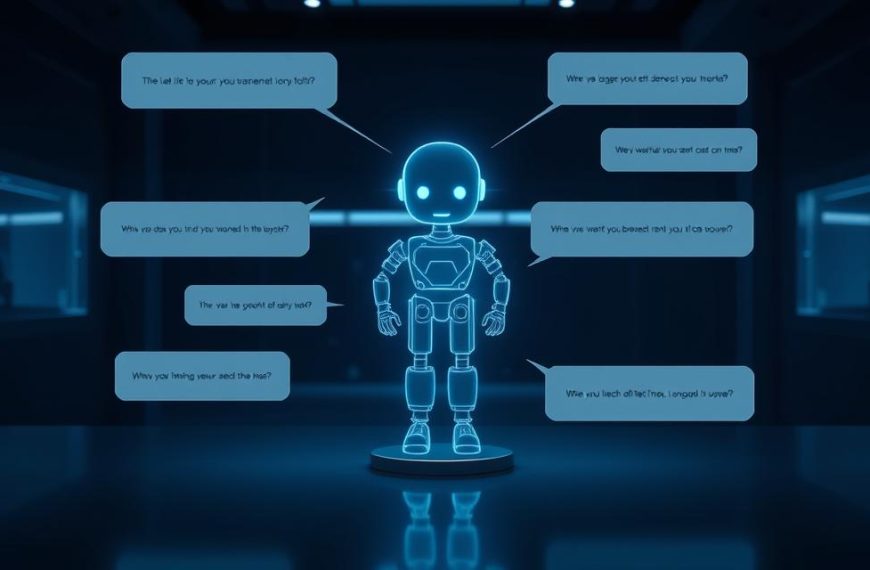Artificial intelligence is changing the world, making big impacts in healthcare and business. It brings great benefits but also raises important questions about how to use it right.
Many people working in tech have machine learning questions. They want to know how these systems work and how they can be used in real life. It’s key to understand what AI can do and what it can’t.
Our guide answers common questions about keeping data safe, avoiding bias, and boosting productivity. We also look into how to use AI wisely in different areas. This helps organisations get the most out of AI while being responsible.
This guide is a great place to start for anyone curious about AI’s role in today’s world. It’s perfect for those new to the subject.
Understanding Artificial Intelligence Fundamentals
Before we dive into AI applications, let’s understand the basics. Artificial intelligence changes how we compute, going beyond simple answers. It’s a big leap from old computing ways.
“AI is different. It has a more substantial influence on our work and our processes because it’s able to find patterns that we can’t see and then use them to provide insights and analysis, predictions, suggestions, and even full drafts all on its own.”
AI’s power to spot hidden patterns and act on its own makes it stand out. It’s super useful in many fields and projects.
What Exactly is Artificial Intelligence?
Artificial intelligence means computer systems that do things humans usually do. They can look at data, solve problems, find patterns, and make choices with little help from us.
Unlike old programs, AI learns from data and gets better over time. This learning lets it tackle complex tasks where rules aren’t clear.
Different Types of AI: From Narrow to General Intelligence
The AI world has different levels, each with its own strengths and uses. Knowing these helps us see what’s possible now and what might be in the future.
Narrow AI is for specific tasks. It’s great at what it does but can’t do other things. Most AI today falls into this category.
General AI is a dream for now. It would understand and apply knowledge in many areas like humans do. But, we’re not there yet.
Key AI Technologies: Machine Learning, Deep Learning and Neural Networks
Several key technologies make up modern AI. Each brings its own strengths to different areas.
Machine learning is the base of most AI. It lets systems learn from data without being told how to do every task. As they get more data, they get better.
Deep learning is a more advanced machine learning. It uses complex networks to handle huge amounts of data. This helps find patterns that simpler systems might miss.
Neural networks are like the brain’s way of working. They use nodes to process information. This makes them great for things like recognizing images, understanding language, and predicting what will happen next.
These technologies work together to make AI applications that are changing many industries. They get better with time, thanks to their ability to learn from experience.
Current AI Applications and Real-World Uses
AI is changing how we work and live, from hospitals to corporate offices. These technologies have moved from being just ideas to being useful tools that make a difference in many areas.
AI in Healthcare: Diagnostics and Treatment Planning
Doctors now use AI to improve diagnosis and treatment. These tools can look at medical images with great detail, spotting things humans might miss.
In radiology, AI helps find early signs of diseases like cancer. It works faster than doctors and is very accurate.
AI also helps plan treatments. It looks at patient data and suggests treatments that fit each person’s needs. This takes into account things that might affect how well a treatment works.
AI in Business: Automation and Data Analysis
Companies use AI to make their work easier and stay ahead. AI handles tasks that need to be done over and over, so people can focus on important work.
AI is great at analysing data. For example, Collective[i] uses AI to make accurate sales forecasts quickly. Before, this took a lot of time and effort.
AI chatbots help with customer service, answering simple questions and solving problems. They work all the time and can pass on harder issues to people.
AI in Daily Life: Virtual Assistants and Smart Devices
AI is part of our daily lives, thanks to virtual assistants and smart homes. These systems learn what we like and make our lives easier.
Voice assistants like Siri and Alexa can do lots of things, from setting reminders to controlling devices. They get better at understanding us thanks to AI.
Smart devices use AI to save energy, keep us safe, and make our homes work better. They can change the temperature, lights, and appliances based on what we like and when we’re home.
| Sector | Application | Key Benefit | Real-World Example |
|---|---|---|---|
| Healthcare | Medical Imaging Analysis | Early disease detection | AI radiology assistants |
| Business | Sales Forecasting | Rapid data processing | Collective[i] AI systems |
| Business | Customer Service | 24/7 availability | AI chatbots |
| Daily Life | Virtual Assistants | Hands-free operation | Amazon Alexa |
| Daily Life | Smart Home Systems | Energy optimisation | Learning thermostats |
AI is growing fast, and we need to think about AI ethics and how to use it right. As AI gets more common, we must consider its impact on society.
Companies need to think about AI ethics when using AI. This includes keeping data safe and making sure AI is fair and open. This way, AI can help us without hurting our rights.
The future of AI will be about making it better and finding new ways to use it. AI will keep getting smarter, helping us in healthcare, business, and our daily lives.
Common AI Questions and Misconceptions
Artificial intelligence is growing fast, leading to many questions and myths. This section aims to clear up these concerns with solid facts. We’ll separate truth from fiction in the fast-changing world of AI.
Will AI Replace Human Jobs Completely?
Many fear AI will take over all jobs. But history shows a different story. New tech usually brings more jobs than it takes away.
Think of the car revolution. Cars replaced horses, but new jobs were created. New industries and jobs emerged.
Every tech change has brought more jobs than lost ones. Cars ended horse-and-buggy jobs but led to new careers in car making, fixing, and more.
AI does not replace humans but helps them. It does repetitive tasks, freeing humans for creative work and strategic thinking.
The job market will change, needing new skills. But, history shows AI won’t replace all jobs.
Can AI Become Truly Conscious or Self-Aware?
AI consciousness is a big debate. Current AI, including advanced neural networks, does not have real awareness or feelings.
AI systems process info through algorithms and pattern recognition. They don’t have the same experiences as humans. Even top AI is “narrow AI,” good for specific tasks but not general intelligence.
Discussions on artificial general intelligence (AGI) are ongoing. But, no AI yet shows true self-awareness or consciousness like humans.
Addressing Common Fears About AI Safety
AI safety worries often come from sci-fi, not reality. The AI field takes safety very seriously, with many safeguards and rules.
Important safety steps include:
- Thorough testing before use
- Ethical rules from research groups
- Systems to watch AI behaviour
- Human checks for big decisions
Experts are working hard on AI safety. They aim to make AI systems that are open, accountable, and controlled. These systems should match human values and goals.
While we must stay alert, today’s AI systems are designed with safety first. They are built to be reliable and safe.
AI Development and Implementation
Organisations worldwide are embracing artificial intelligence to transform their operations and gain competitive advantages. The journey from concept to fully functional AI systems requires careful planning and strategic decision-making. Successful implementation depends on understanding both technical requirements and organisational readiness.
How Organisations Are Adopting AI Solutions
Companies across various sectors are implementing AI through different approaches. Many begin with pilot projects in specific departments before expanding company-wide. This gradual adoption allows organisations to test effectiveness and build internal expertise.
Healthcare institutions use AI for patient diagnosis and treatment planning. Financial services firms employ machine learning for fraud detection and risk assessment. Retail businesses leverage AI for personalised recommendations and inventory management.
Three critical elements drive successful AI collaboration:
- Developing a digital mindset throughout the organisation
- Creating integrated organisational structures
- Increasing transparency in AI decision-making processes
Key Considerations for AI Implementation
Implementing AI solutions requires addressing several fundamental factors. Data quality and availability stand as the most critical consideration. Without clean, relevant data, even the most advanced algorithms cannot deliver valuable insights.
Infrastructure requirements must align with the planned AI applications. Some systems need significant computing power, specially those involving complex deep learning models. Organisations should assess their current technical capabilities and identify necessary upgrades.
Staff training and change management represent another vital aspect. Employees need understanding and skills to work effectively with AI tools. Companies should invest in thorough training programmes and create support systems for smooth transitions.
Ethical frameworks and governance structures ensure responsible AI use. These guidelines address data privacy, algorithmic fairness, and accountability measures. Establishing clear policies from the beginning helps prevent issues later.
Building vs Buying AI Solutions
Organisations face an important decision when implementing AI: develop custom solutions or purchase existing platforms. Each approach offers distinct advantages depending on specific needs and resources.
Building custom AI solutions provides maximum flexibility and customization. Companies can tailor systems to their exact requirements and integrate seamlessly with existing infrastructure. This approach often yields better long-term results for unique business challenges.
Custom development requires significant investment in technical expertise and time. Teams need specialists in machine learning and deep learning technologies. The process involves substantial research, testing, and refinement before deployment.
Buying pre-built AI platforms offers faster implementation and lower initial costs. Vendors provide ready-to-use solutions with established functionality and support services. This approach works well for common business needs with standardised requirements.
Pre-built solutions may lack specific features needed for unique processes. Integration with existing systems can present challenges, and ongoing subscription costs accumulate over time. Organisations have less control over future development roadmaps.
| Consideration | Building Custom Solutions | Buying Pre-built Platforms |
|---|---|---|
| Implementation Time | 6-18 months | 1-3 months |
| Initial Investment | High | Moderate |
| Customization Level | Complete | Limited |
| Maintenance Responsibility | Internal team | Vendor |
| Data Security | Full control | Vendor-dependent |
The choice between building and buying depends on multiple factors. Organisations should evaluate their specific needs, available resources, and strategic objectives. Many companies adopt hybrid approaches, combining custom development with selected pre-built components.
Technical capability assessment helps determine the most suitable path. Companies with strong IT departments and data science expertise might lean toward custom development. Those lacking internal resources might prefer established platforms with complete support.
Regardless of the chosen approach, successful AI implementation requires ongoing evaluation and adaptation. Organisations should establish metrics to measure performance and return on investment. Regular reviews ensure systems continue meeting business objectives effectively.
Ethical Considerations in Artificial Intelligence
Artificial intelligence is now a big part of our lives and work. It raises important ethical questions. Companies using AI must think carefully about how it affects them and society.
Data Privacy and Security Concerns
AI needs lots of data to work well. This raises big privacy worries. Companies must protect personal info used for AI training.
Leaks in AI systems can harm a lot. They can reveal private customer data and business secrets. To avoid this, companies need strong security steps.
The European Union’s GDPR is a key rule for handling data. It makes sure companies are clear about how they use personal info in AI.
Algorithmic Bias and Fairness Issues
AI can sometimes show biases from its training data. This happens when it learns from data that already has unfair patterns.
A 2018 study by Joy Buolamwini and Timnit Gebru showed big biases in facial recognition tech. They found it worked well for white men but failed for Black women up to 35% of the time.
“The harms of AI bias have been widely documented. In their seminal 2018 paper ‘Gender Shades,’ Joy Buolamwini and Timnit Gebru showed that popular facial recognition technologies offered by companies like IBM and Microsoft were nearly perfect at identifying white, male faces but misidentified Black female faces as much as 35% of the time.”
Companies using AI for tasks like hiring or lending need to check for bias. Using diverse data and teams can help fix these problems.
Regulatory Frameworks and Governance
Lawmakers are making rules to handle AI’s ethical issues. These rules help ensure AI is developed and used responsibly.
These rules focus on a few key areas:
- Being clear about how AI makes decisions
- Being accountable for AI’s actions
- Ensuring AI is fair and doesn’t discriminate
- Setting standards for AI’s safety and reliability
Companies using AI should set up ethics teams. These teams can look at risks and make sure rules are followed.
As AI gets better, thinking about its ethics will be even more important. Companies that focus on ethics will create more reliable and trustworthy AI.
Future Trends in Artificial Intelligence
The world of artificial intelligence is changing fast. New ideas are coming up that will change how we work and live. Knowing about these trends helps us see what’s next for technology and how it will affect us.
Emerging AI Technologies to Watch
Several new technologies are set to change AI in the next few years. Explainable AI (XAI) is a big step forward. It lets us see how AI makes decisions, which builds trust and helps it get used more.
Other important advancements include:
- Quantum machine learning for solving complex problems
- Neuromorphic computing that mimics human brain architecture
- Generative AI models creating original content and designs
These new ideas will lead to more advanced uses of AI in different fields. They will also make AI easier to understand and use.
The Role of AI in Addressing Global Challenges
AI is a powerful tool for solving big problems. It helps with climate change by analyzing huge amounts of data and predicting trends accurately.
In healthcare, AI can help by doing remote checks and creating treatment plans tailored to each person. This could save many lives. AI also helps with sustainable development by managing resources better and planning smart infrastructure.
Predictions for AI Development in the Next Decade
In the next ten years, AI will see two big changes. Ethics will become a key part of AI, with more training and checks.
There will be a focus on making AI responsibly. This means AI will work with humans, not replace them. It will open up new ways to solve problems and innovate.
These trends suggest a future where AI is used wisely. It will help us advance as a society in a way that’s fair and open.
Getting Started with AI: Resources and Learning Paths
Starting a career in artificial intelligence means choosing the right education and understanding your career options. There are many ways to begin, from university courses to online learning. It’s important to have a plan, whether you’re getting ready for tech interviews or moving from another field.
Educational Resources for AI Beginners
There are many great resources for those new to AI. Websites like Coursera, edX, and Udacity have courses from top universities and experts. These cover basics like machine learning and data science.
Many schools now have AI-focused degrees. These offer a structured learning path and a recognised qualification. For those learning on their own, there are open-source materials, books, and research papers to explore.
Getting practical experience is key. Start with projects and join AI communities. This way, you learn by doing and understanding theory at the same time.
Career Paths in Artificial Intelligence
AI offers many career paths across different industries. Roles include machine learning engineers, data scientists, and AI researchers. Each job has its own skills and career paths.
Machine learning engineers work on AI models, needing programming and math skills. Data scientists look at big data to find insights, needing stats knowledge. Research roles need deep theory and creativity.
Interviews for AI jobs are getting tougher. You need to show you know your stuff and can solve problems. Practice for interviews and keep up with the latest in AI.
As you grow in your career, you might specialise or move into leadership. The AI field is always changing, so keep learning and updating your skills.
Tools and Platforms for AI Development
AI development uses special tools and platforms to make and deploy AI. Popular languages are Python and R, with libraries like TensorFlow and scikit-learn. These are the building blocks for AI models.
Cloud platforms from big names provide the power needed for complex models. Services like AWS SageMaker and Google AI Platform make setting up easier. This lets developers focus on creating models.
Today’s development environments support working together on AI projects. Tools like Jupyter notebooks and version control systems help teams work better. These tools make it easier for developers and teams to work together.
Companies using AI need to think about their tools and platforms. They might choose to build their own or use existing ones, depending on their needs and goals.
Conclusion
Artificial intelligence is a huge leap forward in technology. It’s changing healthcare, business, and our daily lives. This guide shows how AI can solve big problems and make our lives better.
Creating AI responsibly is key. We must think about privacy, bias, and rules. These steps help AI help us, not harm us. Companies using AI need to focus on these important points too.
The Stanford University AI100 study says working together is essential. Technologists, policymakers, and the public must team up. This way, we can tackle challenges and get the most out of AI.
The future of AI looks bright with new technologies on the horizon. Knowing what AI can and can’t do is important. This knowledge helps us use AI wisely as it keeps changing.



















